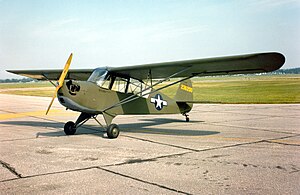Aeronca L-3
| L-3 Grasshopper | |
|---|---|

| |
| Aeronca L-3B belonging to the National Museum of the United States Air Force. | |
| Role | Observation and liaison aircraft |
| Manufacturer | Aeronca Aircraft |
| First flight | 1941 |
| Primary user | United States Army Air Forces |
The Aeronca L-3 group of observation and liaison aircraft were used by the United States Army Air Corps in World War II. The L-3 series were adapted from Aeronca's pre-war Tandem Trainer and Chief models.
Design and development
In 1941, the United States Army Air Corps ordered four examples of the Aeronca 65 TC Defender, designated YO-58, for evaluation of the suitability of light aircraft for observation and liaison purposes. (It also placed similar orders with Piper and Taylorcraft Aircraft). Service tests during the US Army's annual maneuvers proved successful, and resulted in large orders being placed. In 1942, the O-58 was redesignated L-3.[1][2]
When American forces went into combat after Pearl Harbor, the Army Air Force used the L-3 in much the same manner as observation balloons were used during World War I — spotting activities and directing artillery fire. It was also used for liaison and transport duties and short-range reconnaissance which required airplanes to land and take off in short distances from unprepared landing strips. Liaison pilots would train on L-3s before moving on to front-line aircraft like the Piper L-4 or the Stinson L-5. Some L-3s were shipped to north Africa, and subsequently given to the Free French Forces in the area at the time. At least one of the aircraft served with US forces in Italy.[citation needed]
The TG-5 was a three-seat training glider of 1942 based upon the O-58 design. This aircraft retained the O-58's rear fuselage, wings, and tail while adding a new front fuselage in place of the engine. In all, Aeronca built 250 TG-5 gliders for the Army. The Navy received three as the LNR-1.[3]
Variants
O-58 designation replaced by L-3 designation in April 1942[4]
- YO-58 — Four aircraft with a 65 hp (48 kW) Continental YO-170-3 engine.[4]
- O-58 / L-3 — production order of 50, most used for training in the US.[4]
- O-58A / L-3A — Fuselage widened four inches and extended greenhouse canopy. 20 built.[4]
- O-58B / L-3B — Modified canopy and additional radio equipment. 875 built.[4]
- O-58C / L-3C — As O-58B/L-3B but with radio equipment removed for use as trainer. 490 built.[4]
- L-3D — Aeronca 65TF Defender. 11 aircraft impressed.[4]
- L-3E — Aeronca 65TC Defender. 12 aircraft impressed.[4] Continental engine.
- L-3F — Aeronca 65CA Defender. 19 aircraft impressed.[4]
- L-3G — Aeronca 65L Super Chief with side by side seating. 4 aircraft impressed.[4] Lycoming engine.
- L-3H — Aeronca 65TL Defender. 1 aircraft impressed)[4] Lycoming engine.
- L-3J — Aeronca 65TC Defender 1 additional aircraft impressed.[4] Continental engine.
- JR-1 — Three L-3Cs supplied to the US Navy.[4]
- TG-5 — 250 were built as training gliders for the USAAC.[4]
- TG-33 — TG-5 converted for prone pilot.[4][5]
- LNR — Three TG-5s supplied to the US Navy.[4]
Operators
- Brazilian Air Force L-3C
- Aviación Militar - received three L-3Bs.[6]
Museum displays
Aside from 15 L-3s (2 L-3, 7 L-3B, and 6 L-3C) that remain on the US civil registry as of June 2016,[7] a number have also found their way into museums
- National Museum of the United States Air Force at Wright-Patterson AFB near Dayton, Ohio
- United States Army Aviation Museum at Fort Rucker near Ozark, Alabama
- Kalamazoo Aviation History Museum in Kalamazoo, Michigan
- Cavanaugh Flight Museum in Addison, Texas
- Port Townsend Aero Museum at Jefferson County International Airport near Port Townsend, Washington (flown regularly)
- Museo Nacional Aeronáutico y del Espacio de Chile, Santiago, Chile
- American Airpower Heritage Museum in Midland, Texas
- Wings of Eagles Discovery Center in Elmira, New York
- Museum of Flight in Seattle, Washington
- National D-Day Memorial in Bedford, Virginia
- Alamo Liaison Squadron in San Antonio, Texas
- Vintage Flying Museum at Meacham International Airport in Fort Worth, Texas
Specifications (L-3C)
Data from Jane's Fighting Aircraft of World War II.[8]
General characteristics
- Crew: 2: pilot, observer
Performance
See also
Related development
Aircraft of comparable role, configuration, and era
Related lists
Notes
- ^ Swanborough and Bowers 1963, p. 31.
- ^ Mondey 1996, p. 8.
- ^ Swanborough and Bowers 1963, pp. 32–33.
- ^ a b c d e f g h i j k l m n o p Adcock, 2005, p.21
- ^ Swanborough and Bowers 1963, p.584.
- ^ Air International September 1973, p. 121.
- ^ FAA Registry Search for Aeronca L-3 accessed 12 June 2016
- ^ Bridgeman, Leonard. "The Aeronca Grasshopper." Jane's Fighting Aircraft of World War II. London: Studio, 1946. p. 203-204. ISBN 1 85170 493 0.
References
- Adcock, Al (2005). US Liaison Air in Action - Aircraft Number 195. Carrollton, Texas: Squadron Signal Publications. pp. 21–24). ISBN 0-89747-487-2.
- Andrade, John M. (1979). U.S. Military Aircraft Designations and Serials Since 1909. Midland Counties Publications. ISBN 0-904597-22-9.
- Abel, Alan (2001). Aeronca's Golden Age. Wind Canyon Books. ISBN 1-891118-42-0.
- Guillemette, Roger. "Aeronca L-3". US Centennial of Flight Commission. Archived from the original on 4 January 2006. Retrieved 2006-01-04.
{{cite web}}: Unknown parameter|deadurl=ignored (|url-status=suggested) (help) - Mondey, David (1996). The Concise Guide to American Aircraft of World War II. London: Chancellor Press. ISBN 185152-706-0.
- Swanborough, F.G.; Peter M. Bowers (1963). United States Military Aircraft since 1909. London: Putnam.
- "Venezuela Refurbishes Her Aerial Sombrero". Air International. 5 (3): 118–124, 150. September 1973.
- "Aeronca L-3 Aircraft Finder". AeroWeb: The Aviation Enthusiast Corner. City University of New York. Retrieved 2006-01-04.
